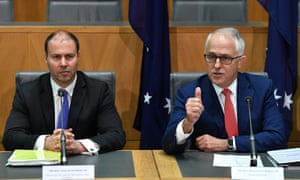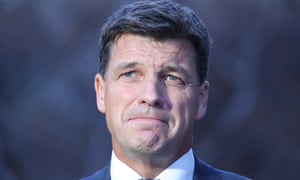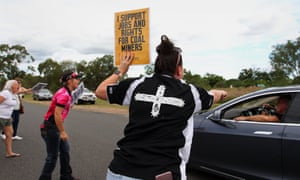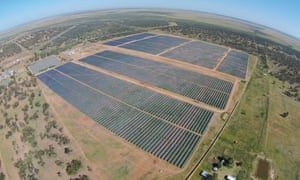Liberal states have caucused, and they want the newly elected Morrison government to reboot the Neg
In
Canberra, a month on from Scott Morrison’s election victory, there is
talk of feasibility studies for a new Queensland coal plant, and a nascent nuclear debate. But if we shift our vantage point to Adelaide, Australia’s near-term energy outlook looks very different.
Dan Van Holst Pellekaan, the Liberal energy minister, is talking about South Australia hitting 100% net renewables by the 2030s. When asked to explain what that means, he tells Guardian Australia “producing more renewable energy in South Australia than we need for our own consumption and exporting the surplus”.
There is no talk of coal, apart from the inevitability of its displacement.
The South Australian renewables export plan relies on a new interconnector with New South Wales. Van Holst Pellekaan says if the proposed interconnector is approved, there are opportunities to construct large-scale solar and wind farms in the north-east of the state, on pastoral land, adjacent to the transmission equipment.
“Then we start to displace coal in NSW,” he says. “It’s not just
about a bit of renewable energy making a difference … that’s where you
start to get a really big win on emissions reduction.”Dan Van Holst Pellekaan, the Liberal energy minister, is talking about South Australia hitting 100% net renewables by the 2030s. When asked to explain what that means, he tells Guardian Australia “producing more renewable energy in South Australia than we need for our own consumption and exporting the surplus”.
There is no talk of coal, apart from the inevitability of its displacement.
The South Australian renewables export plan relies on a new interconnector with New South Wales. Van Holst Pellekaan says if the proposed interconnector is approved, there are opportunities to construct large-scale solar and wind farms in the north-east of the state, on pastoral land, adjacent to the transmission equipment.
But pushing ahead with that kind of progress is much easier if there’s a national framework driving the transition. Post-election, Van Holst Pellekaan wants Canberra back at the table being collaborative, implementing a coherent energy policy.
What the South Australian doesn’t say, but is obvious to people who know how the Coag energy council works, is the states can force this issue if they choose to.
If they can agree among themselves about what needs to happen, they can create a framework setting out the rules of the road even if the commonwealth resists.

Liberal states drive energy policy reboot
The South Australian energy minister is studiously diplomatic, but it’s clear he regards the panicked decision last August as a mistake. He’s not alone. His Liberal counterpart in NSW, Matt Kean, made similar arguments in a recent speech. He said the country could not afford to let “ideological indulgences continue”.Guardian Australia understands the Liberal states have caucused, and they want the newly elected Morrison government to reboot the Neg, or something very like it. Crashing through resistance from the energy minister, Angus Taylor – who was an internal critic of the Neg during the Turnbull prime ministership – won’t be option one, but implicit in the current front-running by the states is “we are prepared to do it if you don’t”.
Van Holst Pellekaan argues that any energy policy in 2019 has to take in emissions reduction, as the Neg model did. “It’s impractical to imagine that emissions reduction couldn’t or shouldn’t be part of energy policy,” he says. “It’s a key component of what’s going on.”
Van Holst Pellekaan is polite but pointed: “I note, as everybody has I hope, that Scott Morrison has given Angus Taylor the title of energy and emissions reduction minister.
“The prime minister has told Angus, at least on the face of it, that emissions reduction is 50% of his responsibility. I’m very optimistic that strong message through the prime minister will be very positive for Australia and the states.”
“We must reduce emissions but I’m convinced we can do that in a sensible well-planned way without having consumers take on the burden with high prices and blackouts.”

Stakeholders regroup after surprise election result
The 18 May election result has been a shock for many stakeholders who work at the intersection of climate and energy policy in Australia. Led by opinion polls, which pointed to a Labor victory, they were strategising for a different outcome. They were preparing for an incoming Labor government intent on reviving the Neg and imposing a higher emissions reduction target of 45% to pull through new investment in low-emissions technology.A re-elected Morrison government means an entirely different outlook. Taylor, thus far, has batted away arguments to revive the Neg, although the word is Morrison may have a different view. The federal renewable energy target will wind down from 2020, and in the absence of a clearly defined emissions reduction target, there’s no clear policy mechanism to encourage investment in large-scale low-emissions projects beyond that point.
Taylor has proposed direct intervention in the market through government underwriting of new power generation, but analysts and some of the states, who have spent time and political capital trying to extract themselves from running power systems, wonder why on earth a Liberal government wouldn’t just set coherent rules and leave the investment decisions to the market.
As well as the demise of the RET, and the uncertainty about the regulatory framework to come, there is also significant concern in the renewable energy sector that the Australian Renewable Energy Agency, which has played a significant role in assisting the transition to date, is funded only until 2022.
"Climate change always comes up behind Australian political leaders and grabs them"
Adding to the friction, the government is also continuing to threaten energy companies with its “big stick” legislation – a proposal which has generated enormous hostility from the energy sector and business groups to the point where Morrison, according to government insiders, has directed Taylor to set about mending fences.
Energy and climate stakeholders are aware there may be a state-led move to revive the Neg, but that’s a double-edged sword. If Canberra continues to be a car crash, refusing to provide necessary national leadership, the states will take energy policy into their own hands, and that’s fine if the end result is harmonised rules, and less fine if it’s a hodge-podge.
If reviving the Neg proves impossible, some insiders who have worked in this policy area for a long time wonder if it might be better to try to re-engage Canberra through the regulation of energy grid architecture – a debate sufficiently arcane and technical to prevent it becoming hostage to the idiocy of hyper-partisan politics.
The Morrison government is locked in through the Paris agreement to undertake reviews of Australia’s targets, a process that will provide a focal point for some of the advocacy over the coming parliamentary term. In the Paris framework which Australia has signed up to, the next two years are supposed to be about “review and ratchet up,” as Emma Herd, the head of the Investor Group on Climate Change, puts it.
A tone of self-reliance is starting to assert itself in business circles. There is talk of ClimateWorks, with business backing, doing an Australian version of a report called Mission Possible. The Energy Transition Commission in Britain in 2018 mapped out how the energy and industrial sectors could achieve net-zero emissions by 2050, and a local version could provide something of a self-help roadmap for businesses in Australia, as well as a prompt for the government.
But he’s also telling his members not to rely on government. Rather than assuming rationality will reassert itself, and project us into a golden period of coherence, Willox is now talking about harm minimisation. “The policy framework can help. There’s no doubt about it. But it can also do a lot of harm. We’re probably at the point of do no harm and let business play this out.”
Willox says the abandonment of the Neg last year was a tipping point in the psychology of the stakeholder debate in Australia.
“The beauty of the Neg was nobody thought it was 100% wonderful, but everyone thought they could work with it,” Willox says. “Everyone got in the cart and when that was blown up, we almost went back to square one in a way.
“That has made business decide we’ve just got to get on with it and be self-reliant.
“We just have to get on with it without them.”

Fears the investment boom in renewables will stall
While the policy failures and accumulated chaos of the past decade has meant investors in old-school power generation are unwilling to build new kit lest they become saddled with stranded assets, the renewables sector in Australia has boomed over the past 18 months, with around $20bn worth of new development.It’s ironic, perhaps, that in an election cycle where a number of regional Queenslanders voted for the promise of blue-collar jobs, backing the party that backed the Adani coal project, renewables generated more than 13,000 actual jobs in construction, with a lot of that activity in north Queensland.
The worry post-election is that the renewables investment boom will stall. “The concern is we will stagger as an industry,” Peter Cowling, who runs Vestas Australia, a major wind turbine manufacturer, tells Guardian Australia.
"What we need is the government to step up and set the direction in the transition"
While Zali Steggall, the independent who managed to unseat Abbott in Warringah on a climate action platform, argues the Morrison government needs to extend the RET beyond 2020 – and the renewables sector may end up lobbying for that if the Neg reboot stalls – Cowling says the industry doesn’t need subsidies if the government can deliver a clear direction that gives companies certainty to invest.
Kane Thornton, who runs the Clean Energy Council, says the cost of large-scale renewable energy has come down significantly over the past five years. “It is now the lowest-cost form of new generation. But the reality is that without a clear strategy and policy there will be uncertainty about investment.”
Cowling says as a corporate player in the energy market, it is clear why the Morrison government needs to step back into the frame: “You wouldn’t dream of government pulling out of the planning of roads, or where you put an airport, and Australia’s electricity grid is more complex than those things.
“What we need is the government to step up and set the direction in the transition. If I only have a five- to 10-year horizon as an investor, I’m going to charge a much higher risk premium for getting involved in Australia. If I can look out over 30 years, Australia will get much cheaper energy.”
He says Australia has two options – a glide path to zero emissions by mid-century that is elegant or one that is chaotic. “If you don’t have an elegant glide path to retirement, and replacement of ageing coal assets before retirement, then you are setting people up for much greater grid risks than anyone could have from the fact that renewables are intermittent.”
Those grid risks are already evident, with ageing coal assets struggling to meet demand from consumers and businesses.
“If we don’t do the planning, this transition is much harder,” Cowling says. “I’ve been searching for an appropriate analogy and the best I can come up with is roads and airports.
“Imagine if we left it to the market to dispatch police or ambulances – we wouldn’t do it, but we are close to that with electricity.”

No comments:
Post a Comment